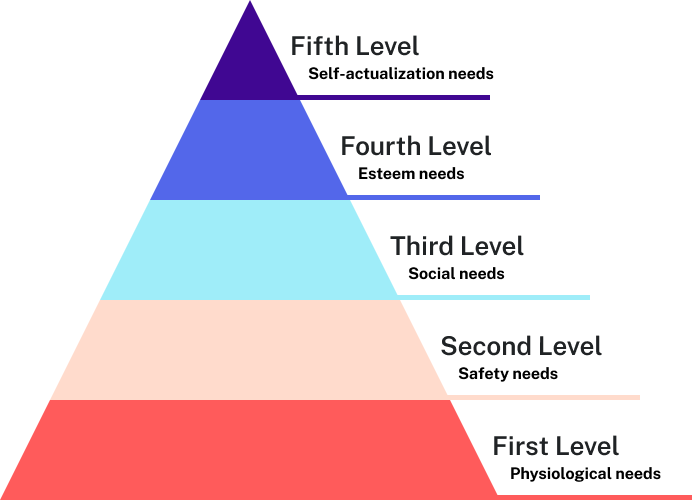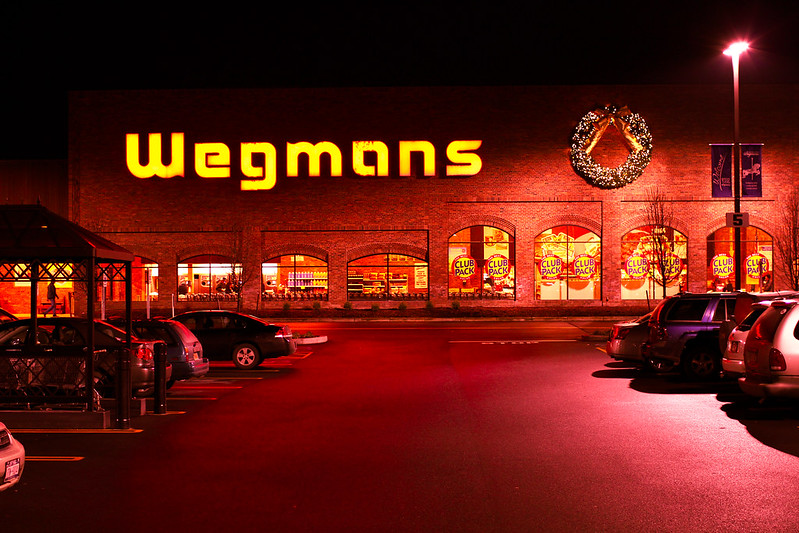- List the levels of need in Maslow’s hierarchy
- Explain how Maslow’s hierarchy relates to worker motivation
- Understand how Herzberg differentiates between intrinsic and extrinsic motivators
- Understand how employees can be motivated by using McClelland’s acquired needs theory
Hierarchy of Needs
Psychologist Abraham Maslow, proposed a theory of motivation based on universal human needs. Maslow believed that each individual has a hierarchy of needs, consisting of physiological, safety, social, esteem, and self-actualization needs. Maslow’s theory of motivation contends that people act to satisfy their unmet needs. When you’re hungry, for instance, you look for and eat food, thus satisfying a basic physiological need. Once a need is satisfied, its importance to the individual diminishes, and a higher-level need is more likely to motivate the person.

According to Maslow’s hierarchy of needs, the most basic human needs are physiological needs, that is, the needs for food, shelter, and clothing. Physiological needs typically motivate a person to find a job. People need to earn money to provide food, shelter, and clothing for themselves and their families. Once people have met these basic needs, they reach the second level in Maslow’s hierarchy, which is safety needs. People need to feel secure, to be protected from physical harm, and to avoid the unexpected. In work terms, they need job security and protection from dangerous work conditions.
Physiological needs and safety are physical needs. Once these are satisfied, individuals focus on needs that involve relationships with other people. At Maslow’s third level are social needs, such as needs for belonging (acceptance by others) and for giving and receiving friendship and love. Informal social groups and relationships with others on and off the job help people satisfy these needs. At the fourth level in Maslow’s hierarchy are esteem needs, which are needs for the respect of others and for a personal sense of accomplishment and achievement. Satisfaction of these needs is reflected in feelings of self-worth. Praise and recognition from managers and co-workers contribute to the sense of self-worth. Finally, at the highest level in Maslow’s hierarchy are self-actualization needs, or needs for fulfillment, for living up to your potential, and for using your abilities fully.
Maslow argued that a higher-level need was not activated until a lower-level need was met. He also claimed that a satisfied need is not a motivator. A person who has plenty to eat is not motivated by more food (the physiological hunger need). Research has not verified these principles. The theory also concentrates on moving up the hierarchy without fully addressing moving back down the hierarchy, something that could happen if you experience job loss, for example. Despite these limitations, Maslow’s ideas are very helpful for understanding how to motivate workers by addressing these needs.
Wegmans Food Markets[1]

When you think of your first-choice career, you probably aren’t thinking about working in a supermarket. With grueling hours, low pay, and annual turnover often approaching 100 percent, supermarkets are generally not considered the best places to work—unless you work at Wegmans, which has been on Fortune’s “Best Company to Work For” every year since the list started, earning Wegmans a spot on Fortune’s “Great Place to Work Legends” list.
Part of what makes Wegmans successful is the company’s attention to its employees’ needs at all levels of Maslow’s hierarchy. The company pays above-market wages (the sous chef at a Pittsburgh store used to work for Thomas Keller’s French Laundry in Napa Valley, and talent like that doesn’t come cheap), and until 2003, Wegmans paid 100 percent of its employees’ medical insurance premiums (physiological needs). Wegmans’ most comparable competitor has a turnover rate of about 19 percent, which doesn’t even come close to Wegmans’ 5 percent. More than half of Wegmans’ store managers began working there in their teens (safety needs).
Wegmans’ Culture
Because employees stay so long, the Wegmans culture has become stronger and more ingrained over time. Edward McLaughlin, director of Cornell’s Food Industry Management Program, says, “When you’re a 16-year-old kid, the last thing you want to do is wear a geeky shirt and work for a supermarket. But at Wegmans, it’s a badge of honor. You are not a geeky cashier. You are part of the social fabric,” (social needs). Sara Goggins, a 19-year-old college student, was recently complimented on the display she helped prepare for the store’s French-inspired patisserie—by Danny Wegman himself (esteem needs). Sara keeps a photo of her and Danny Wegman behind the counter. Maria Benjamin used to bake “chocolate meatball cookies” to celebrate coworkers’ birthdays. They were so popular that she asked Danny Wegman if the store would sell them in the bakery department. He said yes, and it did.
Employees like Sara and Maria are routinely recognized for their contributions to the company (esteem needs). Wegmans has spent over $54 million for college scholarships to more than 17,500 full- and part-time employees over the past 20 years. Top management thinks nothing of sending store department managers on training expeditions. A cheese manager might take a 10-day trip to visit and study cheesemakers in London, Paris, and Italy; a wine manager might take a company-sponsored trip through the Napa Valley (self-actualization needs). As you can see from this extended example, Wegmans works hard to meet its employees’ needs at all levels.
- “Wegmans Food Markets #2,” Fortune, http://fortune.com, accessed October 30, 2017; “20th Year in a Row: Fortune Names Wegmans One of 2017 Fortune 100 Best Companies to Work For, Ranking #2,” https://www.wegmans.com, March 9, 2017; Claire Zillman, “Secrets from Best Companies All Stars,” Fortune, http://fortune.com, March 9, 2017; Matthew Boyle, “The Wegmans Way,” Fortune, January 24, 2005, pp. 62–68. ↵